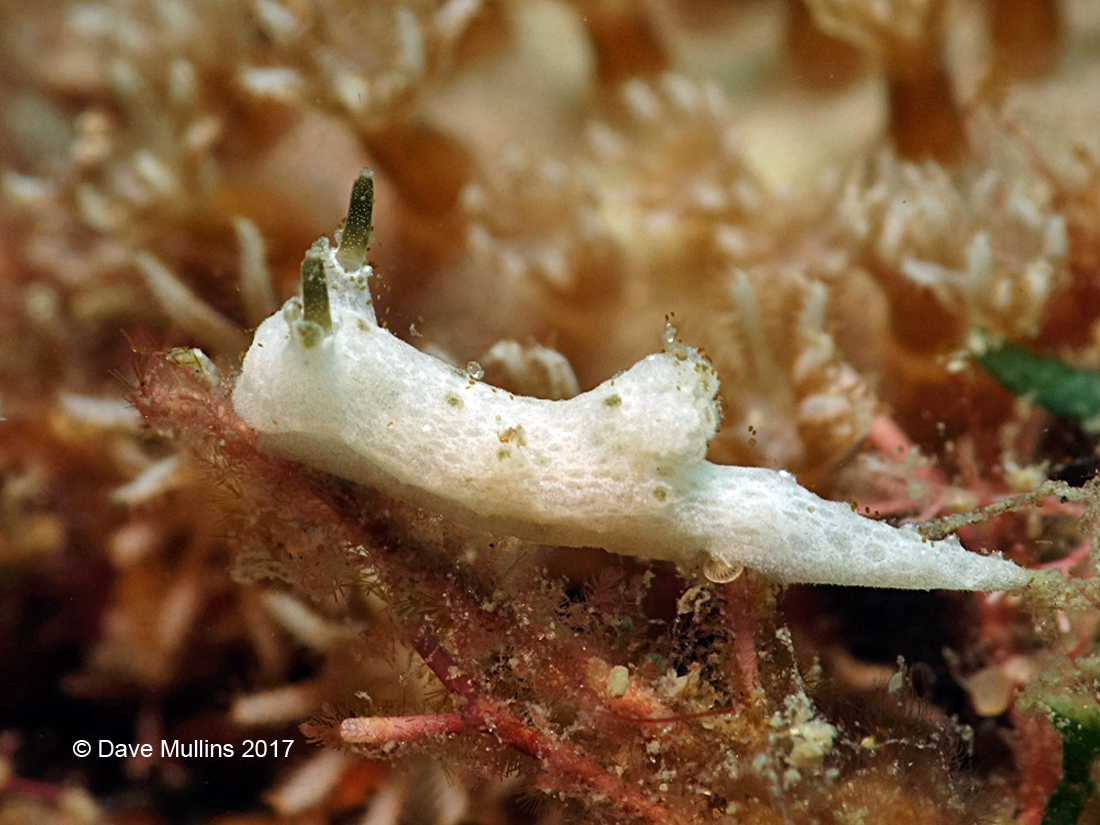 |
Image courtesy of Dave Mullins
12 metres, on The Wall, Old Woman Island, Sunshine Coast, SE Queensland, Australia
Sony DSC-RX100 in Nauticam Housing with wet macro diopter, Inon Z220 strobe.
Aegires hapsis Fahey & Gosliner, 2004
Some sea slugs are rare, or perhaps put more correctly, rarely sighted. Sometimes though this does not prevent their being described and named. This can be due to the current, and highly prudent, method of describing new species within a framework of a genera or family review. In some circumstances there may only be one or two specimens available of a rare species to include in that review, a situation that is not desirable, but nevertheless necessary in order to provide the broadest possible range of data upon which to base taxonomic decisions. The featured species this week, Aegires hapsis, falls into that category.
First described in 2004 from just a single specimen collected from Okinawa, Aegires hapsis at the time was only known from that region and even then had only been sighted twice. Over the past thirteen years there have been minimal, widely scattered sightings recorded from Indonesia (two), Philippines (one) and SE Queensland, Australia (six).
This is a small nudibranch of 6 to 8 mm in length. The dorsal surface has small regularly arranged raised tubercles along the sides and in the midline behind the gills. These tubercles sprout fine spicules from their tops. The background colour is a dark cream with numerous very fine brown dots overlaid with a white reticulation. This combination gives it an appearance somewhat of a sponge's texture and in fact the name hapsis, chosen by the authors, comes from the Greek meaning mesh. A few larger brown spots are evident between rhinophores and gills. The gills actually are quite small, white and almost hidden by the three large, stubby protective appendages that are each branched into 4 or 5 lobes. The rhinophores are dark brown with fine white specks and as with all the Aegires species are smooth and arise from raised pockets. These pockets bear three large flat-topped tubercles (brown on top) to the lateral edge of their rims. All these features are readily discernable in the above image. It feeds upon sponges like all the Aegiridae.
Of the photographic records currently available the specimens from SE Queensland most closely match the holotype from Okinawa.
If any sea slug could be considered rare, ephemeral even, Aegires hapsis without doubt also falls into that category.
References:
Fahey, S. J. & Gosliner, T. M. (2004) A Phylogenetic Analysis of the Aegiridae Fischer, 1883 (Mollusca, Nudibranchia, Phanerobranchia) with Descriptions of Eight New Species and a Reassessment of Phanerobranch Relationships. Proceedings of the California Academy of Sciences, 55, (34): 613-689, December, 2004.
Queensland, Australia
January 2018
Send Dave email at: marineimages@hotmail.com
Dave Mullins on location
 |
|
Nudibranch reference material comes in many shapes and sizes but primarily books and websites. The problem with reference books is outdated material and their weight when travelling. Taxonomy is changing and adding or altering names at a rapid rate. The problem with the Internet is range and accessibility.
Now, thanks to the development by and ongoing efforts of Gary Cobb there is a series of smart device applications called Nudibranch ID. You'll be able to reference nudibranchs from around the world.
No web connection required and fully searchable.
The Nudibranch ID App Series:
These field guides will place right at your fingertips, anytime and anywhere, an outstanding selection of Nudibranchs found throughout the World.
Featuring:
Central Indo Pacific - 801 species
Eastern Pacific - 431 species
Australia/New Zealand - 1135 species
Eastern Atlantic/Mediterranean Sea - 691 species
Western Atlantic - 510 species
Indian Ocean/Red Sea - 702 species
Western Pacific - 785 species
Available as Apple or Android versions.
These are true Apps not just simple identification guides. Search functions and the ability to create lists for emailing are game breakers in this field. They are updated (for free) regularly.
Visit: www.inudibranch.com for a full description.
 |
